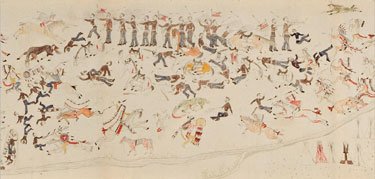Tulsa Exhibition: Eyewitness Drawings of Battle of the Little Bighorn
Battle of the Little Bighorn, Exhibitions, Philbrook Museum of Art, Stephen Standing Bear
Decades after the 1876 Battle of the Little Bighorn, Stephen Standing Bear, who participated in the tumultuous engagement, recalled its chaos: “I could see Indians charging all around me. Then I could see the soldiers and Indians all mixed up and there were so many guns going off that I couldn’t hear them.†He also illustrated the battlefield as he saw it in large-scale muslin pictographs, with the largest surviving example currently on view in First Person: Remembering Little Bighorn at the Philbrook Museum of Art’s downtown branch in Tulsa, Oklahoma.
“The number one question I’m asked about this muslin is: ‘which one is Custer?’ And you don’t see Custer on the muslin,†Christina Burke, Philbrook’s curator of Native American and non-Western art, told Hyperallergic. “If you look closely at the figures, all of the soldiers look exactly the same, and that’s from the Lakota perspective. The details were in identifying the warriors, their shields, their headdresses, the paraphernalia, all of those are real three-dimensional people. The enemies all look the same because it didn’t matter which one Custer was, they were all enemies encroaching on Lakota territory and their way of life.â€
For those who can’t make it to Tulsa, an online interactive allows users to scroll through the muslin and click on points of interest, which highlight this detail of individual warriors. Two Lakota members of the Stokà Yuhà (Bare Lance) Society hold crooked lances in their right hands, while a member of the Miwátani Society has his red sash staked in the earth, a sign that he was going to stay and fight to the death. A member of the Brave Heart Society is “counting coup†with his eagle feather lance, an act of bravery that required a person to get close enough to hit an enemy by hand.








